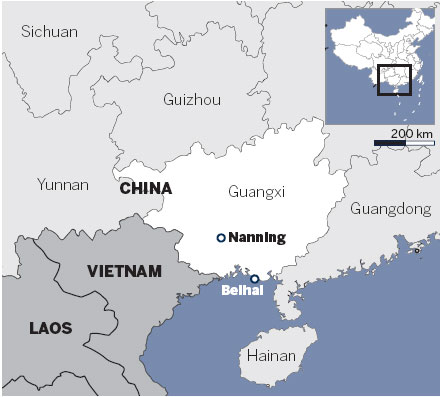Sea break
Updated: 2012-01-20 07:36
(China Daily)
|
|||||||||||
|
Silver Beach takes its name from the silver-colored soft sand that shines under the sun. Provided to China Daily |
Fast-growing city is still an ideal vacation spot
It served as a stop on the Silk Road 2,000 years ago, but today it is best known for its tropical climate and its beaches of silver sand. While Beihai, in southern Guangxi Zhuang autonomous region, may be idyllic now, a visit may well be in order before that changes.
The city has a relatively small population of 1.5 million, but the international group the City Mayor's Foundation says it is predicated to be the world's fastest growing urban area between 2006 and 2020.
Beihai, which means "north of the sea", is on the northern bank of Beibu Gulf, more commonly known as the Gulf of Tonkin, across from Hainan island.
While it is not as popular as Hainan or the coastal city of Xiamen in eastern China's Fujian province, Beihai is the perfect combination of both. Apart from its subtropical landscape, Beihai is filled with architectural legacies left by eight Western countries from the late 19th century.
It is estimated that the city's population will grow 10.6 percent annually. So before the city gets too crowded, pay a visit to this coastal city in southern China.
Silver Beach
Beihai is considered one of the most livable cities in China - Weihai in Shandong province, Zhuhai in Guangdong province and Xiamen in Fujian province being the others on the short list - for its mild climate, fresh air and long stretches of sandy beaches. The best place to experience all of this is at Silver Beach, which is 24 kilometers in length.
The beach is located in southern Beihai and takes its name for its silver-colored soft sand that shines under the sun.
You can also take a boat out to the vast sea in one of the local fishing boats. Fishermen's families, known as danjia, have been in the business for generations. In ancient times they were banned from coming onto dry land and spent their lives on a tiny fishing boat.
The beach in Beihai is a paradise, with an annual average temperature of 22.9 C, ideal weather for a swim from April to November. Known for its clean air quality, there are numerable local nursing homes and recovery centers in Beihai that offer a break from the busy city life.
Weizhou Island
As the biggest extinct volcanic island in China, Weizhou Island possesses the unusual charm that sets itself apart. It is now mostly inhabited by Hakka people.
A Gothic-style Catholic church built by the French in the late 19th century can be found in Shengtang village. Vietnamese-style temples and pagodas are scattered around the island.
Xingdao Lake
Xingdao Lake, or Star Island Lake, is home to 1,026 small islands that dot the blue waters. Unlike the Beibu Gulf, this is a freshwater lake. Visitors can get a taste of the local life as many of the families here offer services including dining and accommodation.
It also served as one of the settings for the television drama Outlaws of the Marsh, a Chinese literary classic. Scenic spots have been set up based on the story.
Local delicacies
While you are in Beihai, don't miss the variety of fresh seafood it has to offer. The most unique seafood of Beihai is shachong, also known as sandworms. Though they look unpalatable, fried sandworms have a crispy outer crust and chewy texture inside. They can also be steamed or barbecued. Dried and cured versions of sandworms are considered a precious gift for friends and family members. They are sold at about 600 yuan ($94, 72 euros) a kilogram.
Beihai also boasts a variety of noodles. Depending on the broth, there are beef noodles, pigs' feet noodles and spiral shell noodles. A bowl of hot noodles or wonton is a typical Beihai-style breakfast.
The city is home to many tropical fruits, such as lychee, mango and coconuts. Suanye, a local snack made from pickled and sliced fruits and vegetables, is popular here.
Beihai is abundant in pearls, but it could be a little tricky for outsiders to figure out the genuine ones, and caution is recommended.
Architectural legacies
In the late 19th century, eight Western countries set up representative offices and churches in Beihai. Fifteen of these buildings remain, displaying the various architectural styles that have been admired for more than a century.
The eight countries are Britain, the United States, Germany, Austria, Hungary, France, Italy, Portugal and Belgium.
China Daily

Today's Top News
Rescuers race against time for quake victims
Telecom workers restore links
Coal mine blast kills 18 in Jilin
Intl scholarship puts China on the map
More bird flu patients discharged
Gold loses sheen, but still a safe bet
US 'turns blind eye to human rights'
Telecom workers restore links
Hot Topics
Lunar probe , China growth forecasts, Emission rules get tougher, China seen through 'colored lens', International board,
Editor's Picks

|

|

|

|

|

|






